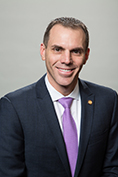
Christopher L. Reeves, MS, DPM, FACFAS
ACFAS President
What should the public expect from a hospital credentialed foot and ankle surgeon? The Joint Commission (TJC) standards and/or Medicare Conditions of Participation (CoP) specify that evidence of license, competence, relevant training and ability to perform the procedures the privileges requested should form the basis or privilege delineation and the available clinical privileging in an acute or ambulatory setting should represent the scope of practice as defined by state law.
Our profession continues to evolve to serve the needs of our patients and ACFAS is committed to the post-graduate education of our American Board of Foot and Ankle Surgery (ABFAS) certified and qualified members and the advancement of our surgical specialty. In all professions, board certification provides a stamp of approval, allowing the public to recognize that a board-certified physician has met a rigorous set of standards with a demonstrated degree of competency. In our profession, the ABFAS certification distinction is especially important for public trust and allows or other medical providers a clear understanding of the training and competencies required to be a board-certified foot and ankle surgeon.
Recently, there has been a lot of “noise” discussing alternative pathways in the pursuit of hospital surgical privileging and a movement to make other board certifications, other than ABFAS, acceptable as a means of surgical competency. One may ask, why such a movement would exist? While the answers to that question may in fact be a chameleon riddled with controversy and conflicts of interest, the crux of the issue, like many controversial battles (i.e. scope of practice battles between similar specialties), doesn’t lie in the altruistic words of “public safety,” but in economics and market share. Our patients and our members deserve more than petty fights over market share and finances. Our patients deserve to have confidence in the recognized qualification of their chosen surgeon and our members deserve to be recognized as the experts in foot and ankle surgery.
ABFAS has set forth a standardized process in which the board-certified foot and ankle surgeon possesses the surgical knowledge and skills required to effect appropriate patient outcomes. This heavily scrutinized process promotes patient confidence, allows for hospitals to understand and recognize competencies for privileging and provides the opportunity to highlight the surgical expertise of our profession for insurers. It is my belief that the proponents of any other alternative pathway is poised to “turn back the clock” on a profession and a sub-specialty after years of marching towards parity.
These aren’t just my musings but are in fact the backbone of ACFAS. In 1938, chiropody/podiatry as primarily focused on topical medicine, biomechanics, and other non-surgical treatments, but William J. Stickel, the then-executive secretary of the National Association of Chiropodists, called for the creation of a “qualifying surgical organization” to create measurable standards of competency for hospital privileging in foot surgery. Four years later, ACFAS was founded to do just that … and (long story short) in 1963 when ABFAS was created and picked up the baton it has been the surgical specialty that transformed this profession – to a point where 47 states now have ankle in their scope of practice acts, DPMs are fully integrated into hospitals, and professional parity is a reality. Additional proof are the many state statutes and hospital credentialing rules specifically mentioning ABFAS surgical certification. To believe otherwise is a false alternative.
Standardization of the education and training of podiatric surgeons has been instrumental in earning credibility towards parity with allopathic and osteopathic colleagues. The now uniform three-year post-graduate training curriculum ensures that all podiatric surgeons have been exposed to a comprehensive educational program, providing a strong foundation for further advanced training. However, not all residents will be, want to be, or should be surgeons—and those physicians have the option to pursue a separate certification process and an ability to have a very successful practice without ever stepping into an OR. There are equivalent examples in the allopathic/osteopathic medical world and successful contemporaries in the 20+ (all DPM) practice group that I belong.
ABFAS certification and qualification is codified and is the legally recognized standard for lower extremity surgical competency in state statutes, hospital regulations, and public awareness. It has been the solution to many state ankle scope battles. Any dilution of our competency would add more fuel to the complaint that our profession’s surgical certifications are confusing and would be irresponsible to the progress of our profession.
Doctors, we have come too far to “turn back the clock.” For 78 years this profession has scraped and fought for recognition, but the 1969 movement to a state-of-the-art surgical certification transformed our specialty. The long-held position of ACFAS is that the credentialing process for granting surgical
privileges be uniformly applied to ALL surgeons seeking privileges, and that those “surgical” privileges should be represented by a standard set of criteria set forth by ABFAS. I am proud to say that ACFAS members are the proven leaders of this standard and continue to change lives every day. We are the voice to quell the noise.
